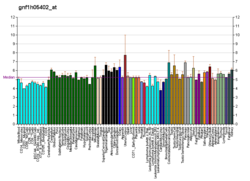Olfactory receptor 52D1 is a protein that in humans is encoded by the OR52D1 gene .[ 5]
Olfactory receptors interact with odorant molecules in the nose, to initiate a neuronal response that triggers the perception of a smell. The olfactory receptor proteins are members of a large family of G-protein-coupled receptors (GPCR) arising from single coding-exon genes. Olfactory receptors share a 7-transmembrane domain structure with many neurotransmitter and hormone receptors and are responsible for the recognition and G protein-mediated transduction of odorant signals. The olfactory receptor gene family is the largest in the genome. The nomenclature assigned to the olfactory receptor genes and proteins for this organism is independent of other organisms.[ 5]
Compared to other olfactory receptors such as OR1G1 , OR52D1 has a more narrow/specific range of ligands.[ 6]
Agonists:
^ a b c GRCh38: Ensembl release 89: ENSG00000181609 – Ensembl , May 2017^ a b c GRCm38: Ensembl release 89: ENSMUSG00000073931 – Ensembl , May 2017^ "Human PubMed Reference:" . National Center for Biotechnology Information, U.S. National Library of Medicine .^ "Mouse PubMed Reference:" . National Center for Biotechnology Information, U.S. National Library of Medicine .^ a b "Entrez Gene: OR52D1 olfactory receptor, family 52, subfamily D, member 1" .^ a b c Sanz G, Schlegel C, Pernollet JC, Briand L (January 2005). "Comparison of odorant specificity of two human olfactory receptors from different phylogenetic classes and evidence for antagonism" . Chemical Senses . 30 (1): 69–80. doi :10.1093/chemse/bji002 PMID 15647465 .
Bulger M, van Doorninck JH, Saitoh N, Telling A, Farrell C, Bender MA, et al. (April 1999). "Conservation of sequence and structure flanking the mouse and human beta-globin loci: the beta-globin genes are embedded within an array of odorant receptor genes" . Proceedings of the National Academy of Sciences of the United States of America . 96 (9): 5129–34. Bibcode :1999PNAS...96.5129B . doi :10.1073/pnas.96.9.5129 PMC 21828 PMID 10220430 . Bulger M, Bender MA, van Doorninck JH, Wertman B, Farrell CM, Felsenfeld G, et al. (December 2000). "Comparative structural and functional analysis of the olfactory receptor genes flanking the human and mouse beta-globin gene clusters" . Proceedings of the National Academy of Sciences of the United States of America . 97 (26): 14560–5. Bibcode :2000PNAS...9714560B . doi :10.1073/pnas.97.26.14560 PMC 18958 PMID 11121057 . Malnic B, Godfrey PA, Buck LB (February 2004). "The human olfactory receptor gene family" . Proceedings of the National Academy of Sciences of the United States of America . 101 (8): 2584–9. Bibcode :2004PNAS..101.2584M . doi :10.1073/pnas.0307882100 PMC 356993 PMID 14983052 .




